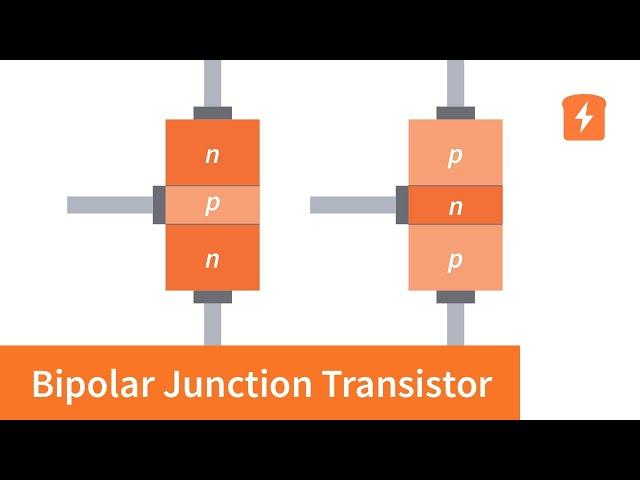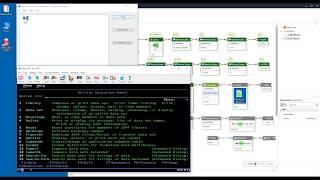
Animated BJT – How a Bipolar Junction Transistor works | Intermediate Electronics
Table of Contents:
0:00 Introduction
0:23 Introduction to the bipolar junction transistor
0:41 The different physical regions of a bipolar junction transistor
0:54 The two junctions that are created in NPN and PNP interfaces
1:29 How a BJT is configured to be an amplifier
1:57 Simplified animated demonstration of how the electrons flow through the different portions of an NPN BJT
3:13 Verbal overview of how a PNP compares to the animated example of the NPN version
For electronics tools, tutorials, equations and more check out our site: https://www.circuitbread.com
And check out our Friends of CircuitBread, who offer special discounts, product samples, resources and more to our users: https://www.circuitbread.com/friends
CircuitBread is joining the fight to help people more easily learn about and use electronics. With an ever-growing array of equations, tools, and tutorials, we're striving for the best ways to make electronics and electrical engineering topics more accessible to everyone.
Connect with CircuitBread:
Instagram ➤ http://instagram.com/circuitbread
Facebook ➤ https://www.facebook.com/circuitbread
Twitter ➤ http://twitter.com/circuitbread
Тэги:
#bipolar_junction_transistor #bipolar_junction_transistor_tutorial #bipolar_junction #npn_transistor_tutorial #npn_transistor #npn_vs_pnp_transistor #bjt_transistor #how_bjt_works #npn_bjt #bjt_amplifier #bjt_electrons #bjt_theory #bjt_demonstration #bjt_animation #animated_bjt #uses_of_bjt #uses_of_bjt_transistor #what_is_bjt #transistor_as_amplifier #npn_type_transistor #pnp_type_transistor #simply_electronics_BJT #bjt_transistor_tutorial #bjt_electrons_explainedКомментарии:

Delivered at the speed of light 😂
Ответить
Nice explanation. A video on exactly how the current is amplified in bjt amplifier?
Ответить
I was confused how collector base junction flow current in reverse bias , cleared my doubt now
Ответить
esta ingles la wea
Ответить
Absolutely wonderful explanation. Thank you.
Ответить
I was very much stuck on this concept, especially why only a small amount of the electrons actually make it through the base. I now get it! Thanks for the high quality explanation and visuals.
Ответить
Sir can you explain about CE configuration
Ответить
I appreciate some others of your videos but threating such interesting and complex subjects in a few seconds without showing what you say step by step with images and formulas it risks to be a useless effort both for advanced viewers who need to refresh some concepts and for intermediate ones which are invested by tons of concepts in a small amount ot time without learning anything.
Ответить
How does a free electron which has recombine with hole of base reagion causes a base current as it is in valence band and not conduction band.
Ответить
Thanks
Ответить
Thanks man. Infinitely more helpful than a university professor!!!
Ответить
i have watched several of your tutorials. They are excellent. My one and only suggestion - please don't speak at the speed of the electrons or holes. Allow a short moment for comprehension of the reader. Please bring more such tutorials. Outstanding stuff.
Ответить
I just love the sound clarity, your accent is just so comfortable to follow. Animations make things so much easier to comprehend. Excellent work. Thanks.
Ответить
We want like this types of explaination ,,with animation's very better as compare to our coaching and collage professor's ,,we want like this kind of deep knowledge.thankyou very much sir.
Ответить
Your every video is such a masterpiece .
Ответить
Josh, I would have liked to also see the PNP mode of operation discussed in detail - I felt that the 30 second blurb at the end to say that 'everything is reversed compared to the npn' did not do it justice. There's something to be said for actually seeing the electron/hole movement - any chance you could include this as an addendum or in the text ?
Ответить
Great information!
Ответить
FET are best
Ответить
Dude, you're a genius.
Ответить
This really helps, but I don't understand why if the base-collector junction is reverse-biased in the NPN, free electrons from emitter to base would cross the reverse-biased base-collector junction and return to the emitter, since reverse-bias does not allow electron flow. Does it have to do somehow with the relative doping density of base, emitter and collector? Please elaborate on that.
Ответить
I heard some terms like drift current and diffusion current in relation to BJT , is the current in the collector considered diffusion or drift ?
Ответить
This was incredibly helpful. Thank you so much.
Ответить
Why did I have to scroll so much to find such a good video. Curse the algorithm
Ответить
Thanks for teaching me what my profs can't lol
Ответить
I love your videos😄
They are always on point!

An underrated channel 👍
Ответить
you said that valence electron move to wire from base but as i know that the valence electrons are attached to its nucleus and didnot move ?corrent me if i am wrong ?
Ответить
But at PN junction, you taught us that when free electrons diffuse across the depletion layer, they lose their energy in overcoming the depression layer, so when they enter the P region, they become valence electrons. But here you said that free electrons pass through the depletion layer easily and they remain free electrons?
Ответить
Slowing down just a little bit would help a lot! Other than that these are great!
Ответить
But what happens inside a BJT when we increase base current in linear region and the collector current increases ok but why the collector emitter voltage starts to be decreasing and after a time both junctions would be forward biased.what happens inside a transistor when it happens?
Ответить
amazinggg
Ответить
Plz explain for pnp I know it is opposite to npn but still don't understand.
Ответить
Thank you for these lectures! Really helpful, looking forward to seeing more content from you guys :)
Ответить
This channel has been really useful to my subject of Electronic Fundamentals, thanks a lot!!
Ответить
Loved the delivery of concepts. Although, I'd love (so would other people watching these videos), if they were delivered a little slower. I felt like there was no time for me to think. Loved it. Kudos!
Ответить

























